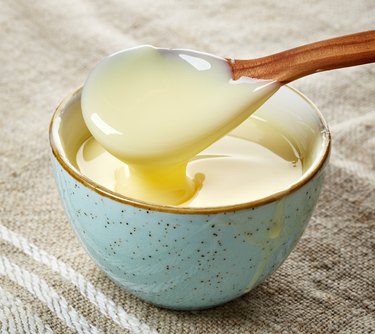
Many recipes would suffer without the taste of vanilla, but the cost of real vanilla extract may not make it an attractive option when you are trying to stretch your food dollars. Imitation vanilla flavoring is lower in cost, but it also offers a variety of advantages and disadvantages. Understanding what these are helps you make the wisest choice for you and your family.
Advantage: Low in Calories and Fat
Video of the Day
Imitation vanilla is often used to add rich flavor to baked goods -- many of which contain a high number of calories and quite a bit of fat. The good news is that imitation vanilla flavoring does not contribute to the fat and calories. A 1-tablespoon serving of this liquid contains 31 calories and no fat. As a rule, you should limit your fat intake to 44 to 78 grams per day if you follow a 2,000-calorie diet.
Video of the Day
Advantage: Low in Sodium
Imitation vanilla flavoring is quite low in sodium, containing 1 milligram of this mineral. Many recipes into which vanilla flavoring is added call for the addition of salt and result in a high-sodium final product, so keeping sodium low in ingredients is important. The American Heart Association calls for most Americans to keep their sodium intake to under 1,500 milligrams per day to avoid aggravating high blood pressure and to reduce the incidence of stroke and heart attack.
Disadvantage: Low in Vitamins and Minerals
Do not rely on imitation vanilla flavoring to boost your vitamin and mineral intake by a significant percentage. One serving of this fluid contains 3 percent of the daily recommended intake of manganese and 1 percent of the riboflavin you should consume each day. While this is not a large amount of either of these nutrients, it does make imitation vanilla slightly useful for keeping your bones healthy and reducing your risk of cardiovascular disease.
Disadvantage: May Contain Alcohol
While you can purchase imitation vanilla flavoring without alcohol, many brands of this flavoring do contain it. One tablespoon can have as much as 4.3 grams of alcohol present to help preserve the vanilla flavor. During the cooking or baking process, the alcohol in this fluid generally burns away; however, cases have been reported of people drinking imitation vanilla flavoring that contains alcohol to achieve intoxication.
Disadvantage: Contains Chemical Additives
Imitation vanilla flavoring relies on lignin vanillin, a chemically produced compound that mimics the flavor of vanillin, the natural extract from real vanilla that produces its flavor. Lignin vanillin is created using wastes produced in the paper manufacturing industry. Some vanilla flavorings also contain glycerin or a glycol base.